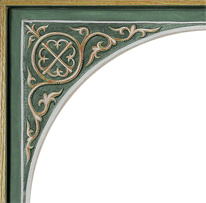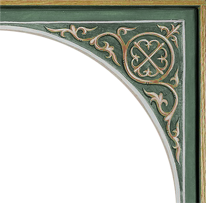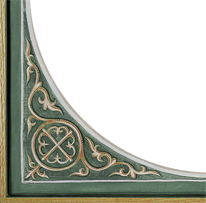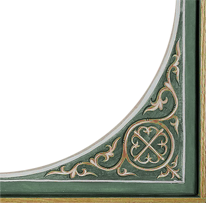20th Sunday After Pentecost
Fathers of 7th Council & St Martin the Merciful
Today we draw from a rich treasury in the Gospel of the raising of the son of the widow of Nain, the commemoration of the holy fathers of the seventh Ecumenical Council, and from the life of our father among the saints, the holy hierarch Martin the Merciful.
Our first treasure is from today’s Holy Gospel wherein we hear the account of the raising of the son of the widow of Nain. Christ and His disciples and a large crowd of followers were traveling from one city to the next and, as they approached the city of Nain, their path crossed with a funeral procession. A young man, the only son of a widowed mother, had died and the dead man was being carried out for burial. When our Lord saw this scene, His heart was filled with compassion for the grieving mother and He approached her and said, “Do not weep.” He then touched the coffin of the deceased and said, “Young man, I say to you, arise.” Immediately, the young man was revived and sat up and began speaking. The shock and consolation and joy of the mother must have been indescribable!
Our second treasure commemorates the fathers of the seventh Ecumenical Council, who defended the icons from those who wished to tear them down. In defending the icons, the Church proclaims the Orthodox understanding of Christ’s incarnation, of God’s redemption of matter, of the transfiguration of physical things by the grace of God. This realization… that God can transfigure what is base and material is a fundamental acceptance and understanding of the reality of Christ’s incarnation, of God’s having taken on human flesh and sanctifying it by His grace. And that sanctification by grace is seen even in simple paintings upon wood. But they are so much more than that. Through the prayer of those who wrote them, and through the prayers of those who have wept before them and poured their hearts out in prayer before them and in memory and honor of those whom they depict… and through the operation of the Holy Spirit, they become transfigured. They become holy – not in and of themselves, but because they represent and can even transmit the holiness of God. And, if God can make something holy of paint and wood… how much more, then, might he do with flesh and blood, with the body, mind, and soul of a human being?
Our third treasure today is found in the life and legacy of our holy father Martin the Merciful, the bishop of Tours. St Martin is one of the bright lights of Orthodox Gaul, the region now known as France. He lived in the 4th century and there are many lessons to be learned from his life. Perhaps the most famous story is when he was still a young man and a soldier. As he was riding upon horseback in the midst of the cold winter, he came upon a beggar who was poorly clothed and shivering. St Martin felt compassion for the man and, drawing his sword, he cut his cape in two and offered the cape to the poor man, who wrapped himself in it and gratefully rejoiced in both the warmth of the cape and of St Martin’s merciful generosity. That night, St Martin had a dream… He beheld Christ sitting upon His throne in heaven, wrapped in the cape of St Martin. Christ proclaimed to the angels surrounding Him: ‘Martin, who is still a catechumen, clothed Me with this robe.’ Here we see the manifestation of Christ’s instruction that ‘whatever you do to the least of these My brethren, you do to Me.’
Each of these three treasures presented to us today are linked together by a common thing…
The thread which ties each of these three together - the raising of the son of the widow of Nain, the affirmation of the icons, and the cape of St Martin – the unifying theme of each of these is the spiritual perception of the image of God.
St Martin, even as a young catechumen, had the spiritual perception to see the image of God in the freezing beggar whom he encountered. And, seeing that image of God in the man, his heart was moved with compassion to care for his brother. That reality was made clear when Christ appeared to him that night and affirmed that whatever we might do to the least of men, we do to Christ Himself.
The Holy Fathers of the seventh Council were graced with this spiritual perception in their defense of the use of icons in Orthodox worship. They affirmed that the icons proclaim and protect the proper doctrine of the Incarnation… that God became man and, in so doing, proved that matter can be redeemed and can become a bearer of grace. St John of Damascus said: ‘I do not worship matter, but the Creator of matter, who for my sake became material and deigned to dwell in matter, who through matter effected my salvation.’
And, of course, Christ our Lord, Who knows all things and sees all things, perceives the image of God in each and every person Whom He created. Christ was never distracted by the distortions of that image which brought spiritual disease to people… He always sought to correct and heal his beloved children. And when He came upon the touching scene of the poor widow who had lost her only son… He was moved with compassion and resurrected the dead man, restoring him to life and reuniting mother and child.
Dear brothers and sisters in Christ, we too must cultivate this spiritual perception to see the image of God – be It in the people surrounding us, in the beauty of an icon, or wherever we may find ourselves. For God is everywhere present and fillest all things. Like St John of Damascus we must not worship matter, but the Creator of matter. Let us lift up our hearts and the eyes of our soul to see the imprint of God’s hand upon all things. If we can have such spiritual vision, then we will find ourselves in paradise and in the presence of God no matter where we are…
May God grant it!
|




